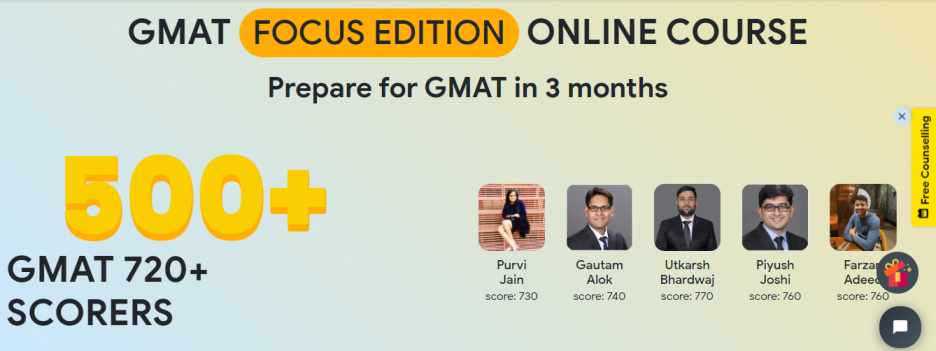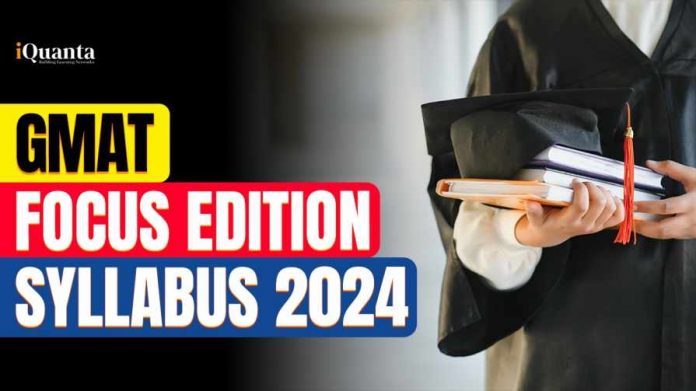The Graduate Management Admission Test (GMAT) has always been a crucial step for candidates aspiring to pursue a graduate Management program. Over the years, the GMAT has evolved to meet the changing needs of Business Schools and candidates, ensuring that it remains a relevant and reliable assessment tool. The GMAT Focus Edition replaced the traditional GMAT on 7th November 2023, which is a revamped format that will be the norm from 2024 onwards. This new version features three main sections: Quants, Verbal, and a unique addition called Data Insights. Notably, the analytical writing section has been eliminated, simplifying the test for candidates. In this article, we will break down the latest GMAT Focus Edition Syllabus for a better understanding.
GMAT Focus Edition Exam Structure Overview
Earlier the GMAT had 3 sections, namely Quants, Verbal Reasoning, Integrated Reasoning and Analytical Writing assessment. The Quant section used to have Problem-Solving and Data Sufficiency Questions. The Verbal Section consisted of Reading Comprehension, Critical Reasoning and Sentence Correction. In the IR and AWA Sections, you have to solve a set that is similar to a data interpretation set and write an essay respectively.
Enroll for GMAT Online Coaching by iQuanta
But under the New GMAT Focus Edition, the Quants section will now solely focus on problem-solving, while Verbal will consist of reading comprehension and critical reasoning. Sentence correction has been minimized, and data sufficiency has been integrated into the Data Insights. Each section is allotted 45 minutes, reducing the total exam time to 2 hours and 15 minutes.
| Features | The GMAT Exam | GMAT Focus Edition |
|---|---|---|
| Exam Duration | 3 hours 7 minutes | 2 hours 15 minutes |
| Sections | Quantitative Reasoning, Verbal Reasoning, Integrated Reasoning, Analytical Writing | Quantitative Reasoning, Verbal Reasoning, Data Insights |
| Question Type | Multiple Choice Questions | Mutiple Choice Questions |
| No. of Questions | Quant – 31 Verbal – 36 IR – 12 AWA – 1 | Quant – 21 Verbal – 23 Data Insights – 20 |
| Exam Cost | $275 | $275 |
| Individual section duration | Quantitative Reasoning- 62 Min Verbal Reasoning- 65 Min Integrated Reasoning- 30 Min Analytical Writing- 30 Min | 3 Sections of 45 Min Each |
| Section Order | Order 1- AWA and IR> Quant > Verbal; Order 2- Verbal > Quant > AWA and IR; Order 3- Quant > Verbal > AWA and IR> | Any Possible Order |
| Flexibility | No option to bookmark, edit or review questions. | Bookmark and Review as many questions as possible; Change up to 3 answers per section. |
| Score Sending | Select five schools to send the score for free before starting the exam | Send Scores to 5 schools for free after knowing your score in both the online and the test center exam. |
| Performance Insights | You can get insights into your performance by purchasing the ESR at an additional cost of $30 | Improved Official Score Report with detailed insights into your performance. |
| Attempts | Five (5) GMAT exam attempts during a rolling 12-month period and eight (8) total lifetime attempts | Five (5) GMAT exam attempts during a rolling 12-month period and eight (8) total lifetime attempts |
GMAT Syllabus 2024 Overview
The Updated GMAT Syllabus consists of three Sections, Quantitative Reasoning, Data Insights and Verbal Reasoning Section.
The Quantitative Reasoning section measures your foundational knowledge in mathematics and how you apply this knowledge to solve problems. It is composed of 21 Problem-Solving questions. These questions require some knowledge of arithmetic and elementary algebra.
Answering these questions correctly relies on logic and analytical skills, not the underlying math skills. You cannot use a calculator while working on this section of the GMAT.
The Verbal Reasoning section measures your ability to read and comprehend written material and to reason and evaluate arguments. It is composed of 23 Reading Comprehension and Critical Reasoning questions.
Reading Comprehension questions measure your ability to understand words and statements, understand logical relationships between significant points, draw inferences, and follow the development of quantitative concepts. Specifically, the following reading skills will be tested: main idea, supporting idea, inference, application, logical structure, and style.
Critical Reasoning questions measure your ability to make arguments, evaluate arguments, and formulate or evaluate a plan of action. Critical Reasoning questions are based on a short reading passage, usually fewer than 100 words. Typically, the short text comes with a question that asks you which of the five answer options strengthens or weakens an argument, tells why the argument is flawed or strongly supports or damages the argument. You will not need specialized knowledge of the subject matter to answer the questions.
The Data Insights section measures candidates’ ability to analyze and interpret data and apply it to real-world business scenarios. It also measures digital and data literacy—one of the most relevant and in-demand skills in business today.
It is composed of 20 questions that ask you to assess how multiple sources and types of information – including graphic, numeric, and verbal – relate to one another and can be leveraged to make informed decisions. Questions may require math, data analysis, verbal reasoning, or all three. You can use an on-screen calculator while working on this section.
The question types you’ll find in this section are:
- Data Sufficiency: Analyze quantitative problems and determine relevant data to solve them.
- Multi-Source Reasoning: Examine data from various sources, recognize discrepancies, and draw inferences.
- Table Analysis: Sort and analyze tabular data to determine relevant information.
- Graphics Interpretation: Interpret graphs and make inferences about relationships.
- Two-Part Analysis: Solve complex quantitative and verbal problems by evaluating trade-offs, solving equations, and discerning relationships.
GMAT Focus Edition Exam Features
Enhanced Efficiency and Flexibility
The GMAT Focus Edition offers several key enhancements that make the exam more efficient and flexible for test-takers. The updated exam is now nearly one hour shorter, with only three 45-minute sections comprising highly focused and business-relevant content. Moreover, candidates now have the flexibility to choose their preferred section order, allowing them to tailor their testing experience to their strengths and preferences.
Improved Insights and Test-Taking Strategies
One of the standout features of the GMAT Focus Edition is the focus on providing better insights to help candidates optimize their test-taking strategies. The exam allows for question review and editing, enabling test-takers to bookmark and review as many questions as they wish. Additionally, candidates can change up to three responses per section, allowing them to refine their answers for improved performance.
Comprehensive Performance Analysis
With the GMAT Focus Edition, candidates now receive a detailed performance report that provides insights into their performance across each section, question type, time management, and more. This comprehensive analysis helps candidates identify their strengths and areas for improvement, empowering them to focus on enhancing their skills for future attempts.
Emphasis on Data Insights
The inclusion of the Data Insights section in the GMAT Focus Edition underscores the importance of data literacy in today’s business landscape. This section assesses candidates’ ability to analyze and interpret data, applying it to real-world business scenarios. Test questions in this section require candidates to evaluate multiple sources and types of information to make informed decisions, with calculator use permitted exclusively in this section.
Total Score Calculation and Percentile Rankings
In the GMAT Focus Edition, the total score is calculated based on equally weighted sections: quantitative reasoning, verbal reasoning, and Data Insights. The total score scale now ranges from 205 to 805, with all total score values ending in a five for easy identification. The addition of percentile rankings provides candidates and schools with valuable insights into individual performance relative to other test-takers, enabling a better understanding of competitiveness across GMAT exam attempts.
Conclusion
The GMAT Focus Edition represents a significant advancement in the world of business school admissions assessments. By incorporating enhanced efficiency, flexibility, insights, and comprehensive performance analysis, the GMAT Focus Edition empowers candidates to showcase their skills effectively and achieve their career ambitions. As the number one most widely used assessment for Global business school admissions, the GMAT Focus Edition sets a new standard for excellence in graduate Management program admissions.
Where to Prepare from?
One must clear the GMAT to get admission into top B-schools of the world. If you are looking for structured preparation along with 24*7 doubt-solving, you can rely on iQuanta’s Course. Practice the most relevant content with iQuanta.



